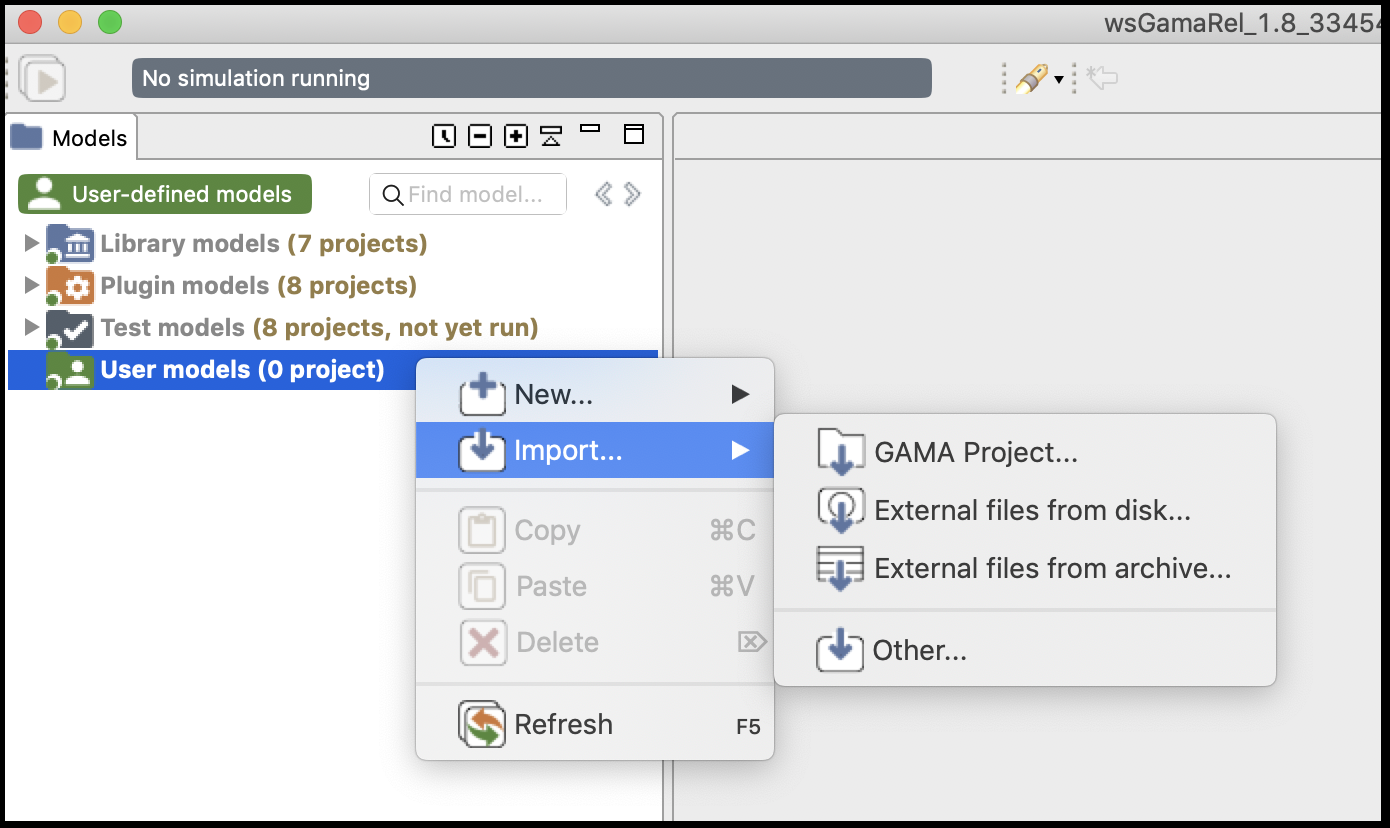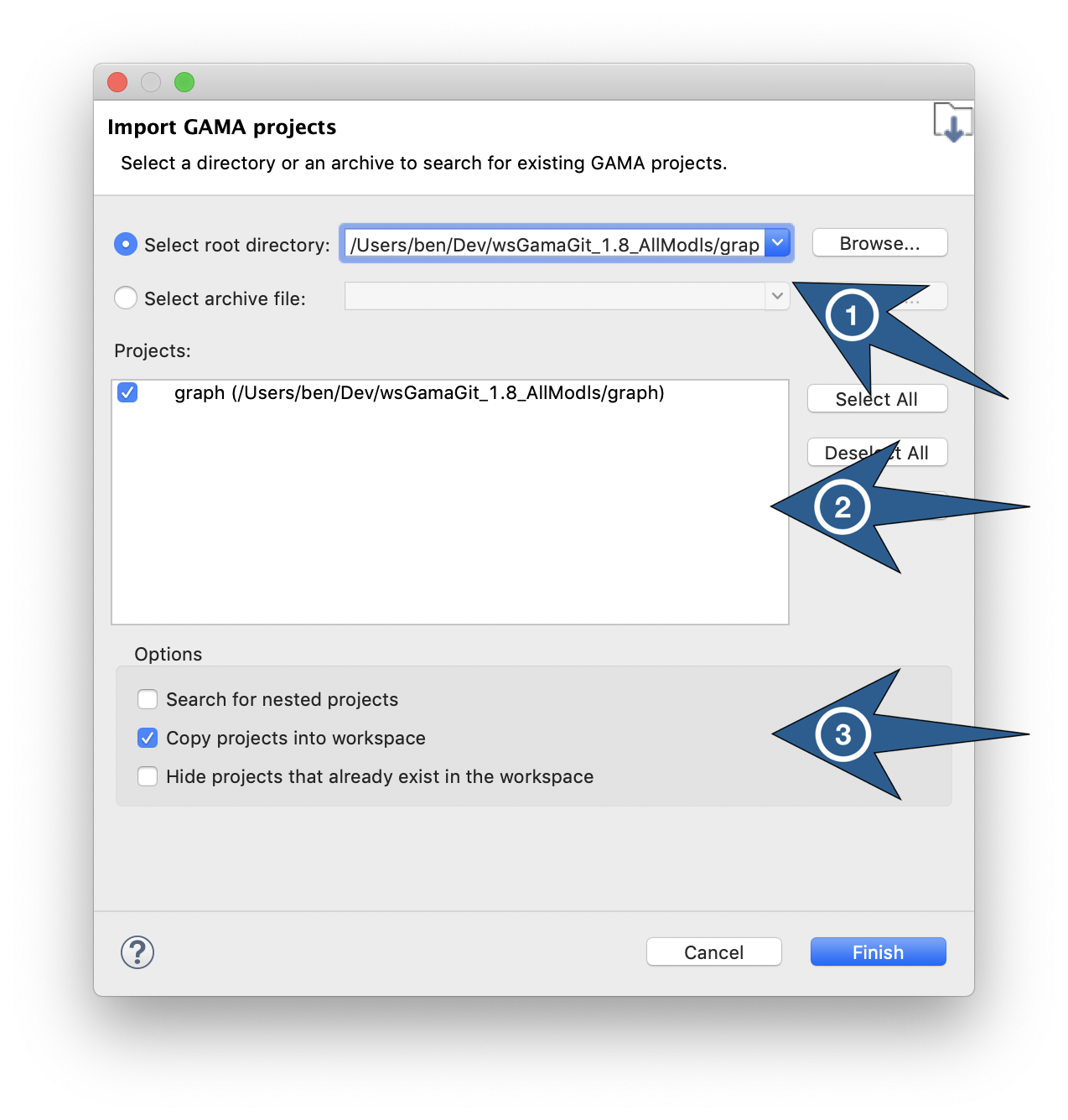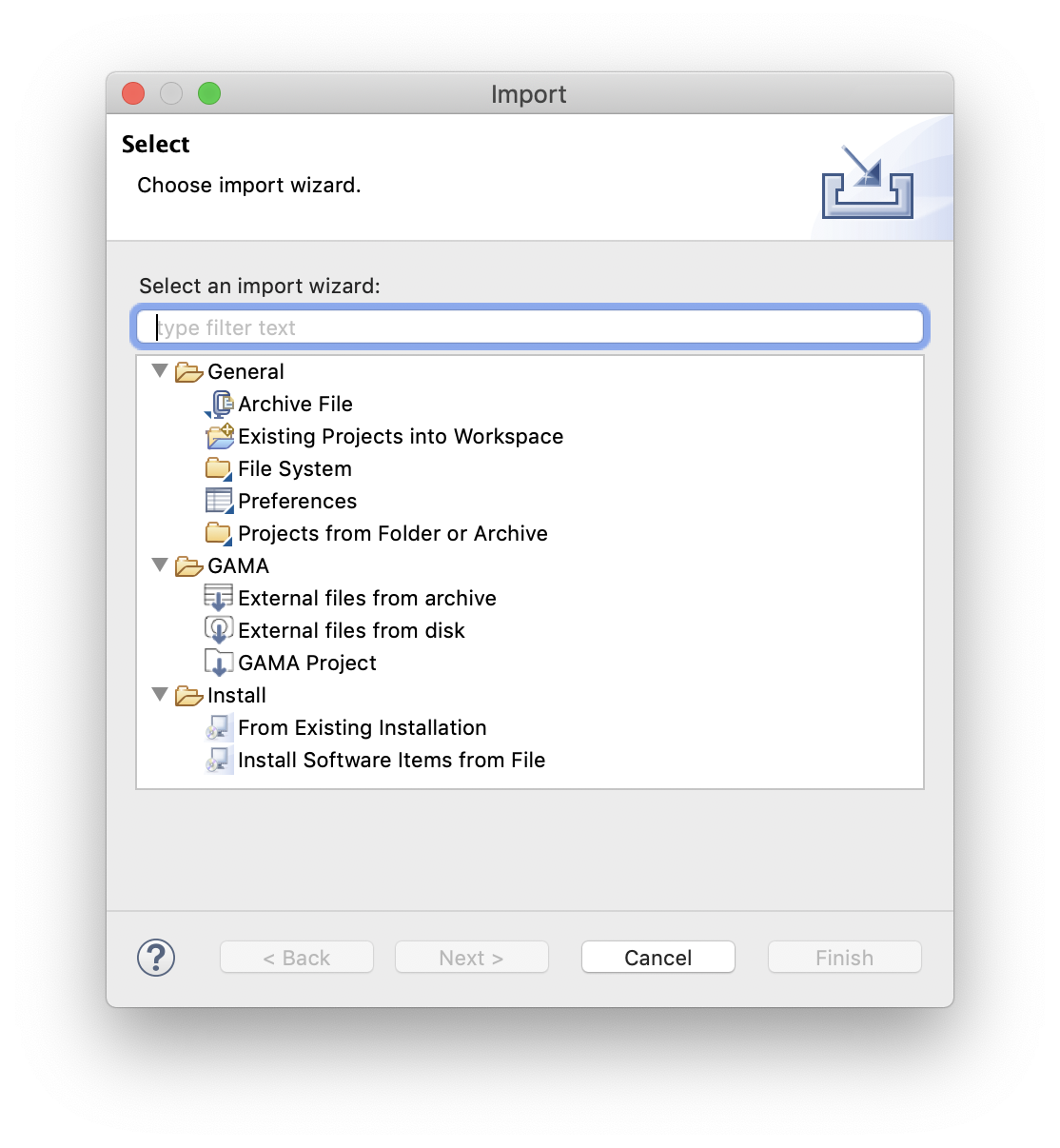-
Notifications
You must be signed in to change notification settings - Fork 99
ImportingModels
Importing a model refers to making a model file (or a complete project) available for edition and experimentation in the workspace. With the exception of headless experiments, GAMA requires that models be manageable in the current workspace to be able to validate them and eventually experiment them.
There are many situations where a model needs to be imported by the user: someone sent it to him/her by mail, it has been attached to an issue report, it has been shared on the web or a Git repository, or it belongs to a previous workspace after the user has switched workspace. The instructions below apply equally to all these situations.
Since model files need to reside in a project to be managed by GAMA, it is usually preferable to import a whole project rather than individual files (unless, of course, the corresponding models are simple enough to not require any additional resources, in which case, the model file can be imported with no harm into an existing project). GAMA will then try to detect situations where a model file is imported alone and, if a corresponding project can be found (for instance, in the upper directories of this file), to import the project instead of the file. As the last resort, GAMA will import orphan model files into a generic project called "Unclassified Models" (which will be created if it does not exist yet).
The simplest, safest and most secure way to import a project into the workspace is to follow instructions from this section.
The simplest, safest and most secure way to import a project into the workspace is to use the built-in "Import..." menu command, available in the contextual menu on the User models (the modeler can only import projects in this category).

The "Import..." command allows the modeler to choose between:
- "GAMA Project...": import a project in the workspace (from another folder or an archive),
- "External files from disk...": import any files in a project of the workspace (from a folder),
- "External files from archive...": import any files in a project of the workspace (from an archive),
- "Other": other ways of importation.
When "GAMA project..." is chosen, a dialog box will pop-up where the user will be asked to:
- Enter a location (or browse to a location) containing the GAMA project(s) to import. This can be the folder of a single project or a folder containing several projects. 2 possibilities are available:
- "Select root directory": the user selects a folder containing the project,
- "Select archive file": the user selects an archive file (e.g. a
.zipfile) containing the project.
- Choose among the list of available projects (computed by GAMA) the ones to effectively import. Only projects that are not already in the workspace can be imported.
- Indicate whether or not these projects need to be copied to or linked from the workspace (the latter is done by default). In the case of an import from an archive, the content will be automatically copied in the workspace.

These two commands allow the user to import some external files into an existing project of the workspace. These two commands are very similar, only the source of files is different: a folder or an archive. They allow to filter and select the files to import. The user will be asked to:
- Enter a location (or browse to a location) containing the files to import.
- Select the files to import.
- Select the project in the workspace where the files will be copied.

When invoked, this command will open a dialog asking the user to choose the source of the importation. It can be a directory in the filesystem (in which GAMA will look for existing projects), a zip file, etc. It is safer, in any case, to choose "Existing Projects into Workspace".
If some extensions have been installed, they could add some entries in this menu (e.g. the Git extension).

Another (possibly simpler, but less controllable) way of importing projects and models is to either pass a path to a model when launching GAMA from the command line or to double-click on a model file (ending in .gaml) in the Explorer or Finder (depending on your OS).
If the file is not already part of an imported project in the current workspace, GAMA will:
- silently import the project (by creating a link to it),
- open an editor on the file selected.
This procedure may fail, however, if a project of the same name (but in a different location) already exists in the workspace, in which case GAMA will refuse to import the project (and hence, the file). The solution, in this case, is to rename the project to import (or to rename the existing project in the workspace).
Currently, there is no way to drag and drop an entire project into GAMA Navigator (or to copy a project in the filesystem and paste it in the Navigator). Only individual model files, folders or resources can be moved this way (and they have to be dropped or pasted into existing projects).
This limitation might be removed sometime in the future, however, allowing users to use the Navigator as a project drop or paste target, but it is not the case yet.
In the case where the Git plugin is installed in GAMA, projects can be imported from a Git repository, as detailed in the recipes related to the use of Git in GAMA.
- Installation and Launching
- Workspace, Projects and Models
- Editing Models
- Running Experiments
- Running Headless
- Preferences
- Troubleshooting
- Introduction
- Manipulate basic Species
- Global Species
- Defining Advanced Species
- Defining GUI Experiment
- Exploring Models
- Optimizing Model Section
- Multi-Paradigm Modeling
- Manipulate OSM Data
- Diffusion
- Using Database
- Using FIPA ACL
- Using BDI with BEN
- Using Driving Skill
- Manipulate dates
- Manipulate lights
- Using comodel
- Save and restore Simulations
- Using network
- Headless mode
- Using Headless
- Writing Unit Tests
- Ensure model's reproducibility
- Going further with extensions
- Built-in Species
- Built-in Skills
- Built-in Architecture
- Statements
- Data Type
- File Type
- Expressions
- Exhaustive list of GAMA Keywords
- Installing the GIT version
- Developing Extensions
- Introduction to GAMA Java API
- Using GAMA flags
- Creating a release of GAMA
- Documentation generation